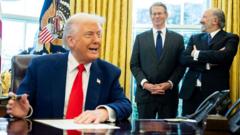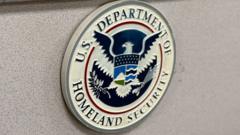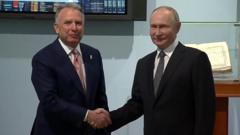Trump's recent trade moves have heightened tensions between the U.S. and China, while providing temporary relief for many of America's trade partners, highlighting the complexities of global trade relations.
US Trade Policy Shift: Tariffs Paused for Most Countries While China Faces Stricter Measures

US Trade Policy Shift: Tariffs Paused for Most Countries While China Faces Stricter Measures
In a major turnaround, President Trump's tariff strategy adjusts to market pressure, easing tariffs for many nations while intensifying sanctions against China.
In a significant policy shift, President Donald Trump announced a 90-day suspension of increased tariffs for most countries, following severe market reactions to his initial trade measures. This decision came just hours after tariffs against around 60 nations took effect, indicating a rapid response to economic turbulence triggered by his administration's earlier strategies.
At the same time, Trump ramped up tariffs on Chinese products to a staggering 125%, worrying investors further amid escalating trade tensions. He accused China of displaying a "lack of respect" after it threatened to impose retaliatory tariffs of 84% on U.S. goods. This latest announcement follows Trump's previous declaration of import taxes on every good entering the country, marking one of the most drastic shifts in the landscape of international trade in decades.
The baseline tariff introduced is set at 10% on all imports, with additional rates imposed on nations categorized as the "worst offenders". These nations include the 27-member European Union, Vietnam, and South Africa, which were expected to face tariffs anywhere between 11% and over 100%. Following Trump's initial announcement, the markets underwent major sell-offs, leading to vast financial losses across global markets and fears of future price increases for American consumers.
As markets reacted, U.S. debt interest rates spiked to their highest level since February, reaching 4.5%. There was a significant bounceback on Wall Street, with the S&P 500 and Dow Jones experiencing substantial gains when news of the tariff pause emerged. Trump highlighted his intention to alleviate pressures on nations that did not retaliate against his tariffs, stating on social media, "If you retaliate, we're going to double it"—a warning specifically directed at China.
Critics of Trump's new policy suggest that he is backtracking under pressure, with some Democratic leaders arguing the move signifies a retreat from a hardline trade position. In response, Trump claimed that the changes were necessary as the situation had made "people [...] getting yippy," and expressed his belief that positive negotiations with China could be imminent.
Meanwhile, the United Kingdom, which was already subjected to the baseline 10% tariffs, commented that the ongoing tensions between the U.S. and China do not favor international trade interests. Current projections from the World Trade Organization indicate that these ongoing trade disputes could impact U.S.-China trade volumes substantially, potentially reducing exchanges by as much as 80%, translating to a staggering $466 billion decline.
In the broader context of Trump's trade policies, several tariffs remain in place, notably a 25% import tax on cars and car parts, which has been active since early April, and similarly imposed tariffs on steel and aluminum imports. European Union officials have initiated their own set of retaliatory tariffs against U.S. goods, set to take effect soon after the news of the U.S.'s tariff modifications, adding another layer of complexity to this evolving trade landscape.
In summary, while Trump’s adjustment provides temporary relief to many nations, it underscores the ongoing economic frictions between the U.S. and China amidst a globally interconnected trade system.























